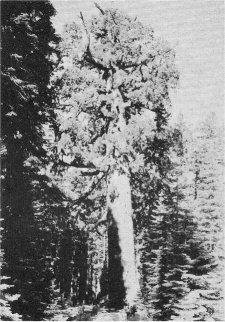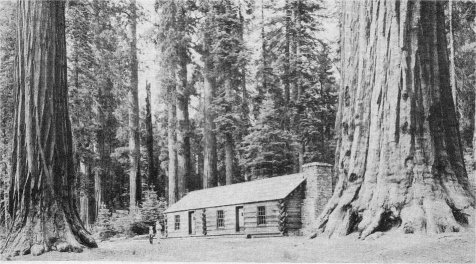
[click to enlarge]
Grizzly Giant
| Online Library: | Title | Author | California | Geology | History | Indians | Muir | Mountaineering | Nature | Management |
Yosemite > Library > Auto Tour > Mariposa Grove of Giant Sequoias (“B”) >
Next: Glacier Point (“G”) • Contents • Previous: Yosemite Valley to Wawona (“W”)
(Total driving distance 4.5 miles)
B-1 GIANT SEQUOIAS. The giant sequoias (Sequoia gigantea), popularly known as “Big Trees,” are probably the largest and oldest living things in the world. Although they are related to the coast redwood (Sequoia sempervirens), there is a striking difference in general appearance and foliage. The giant sequoias are more massive, while the coast redwoods are taller. The bark of the giant sequoias is a golden brown while that of its relative is darker. The burls of redwood souvenirs seen in gift shops are from the coast redwood; burls do not grow on giant sequoias. Flowering of giant sequoias takes place from February to April, the pollen being carried by the wind. In contrast to the great size of these trees, their cones are only 1 3/4" to 2 3/4" in length. Both male and female cones grow on the same tree. After maturing for two years on the tree, the female cone may drop from 150 to 300 seeds. Cones, however, may remain unopened on the trees for as long as 20 years. Usual methods of determining age of trees with boring instruments are not possible in the giant sequoias because of their great size. Accurate age dating in sequoias may be done only by counting the annual rings in fallen trees. Some sequoias have been estimated to be as much as 4000 years old. The wood contains no resin ducts but has a high percentage of tannin This chemical gives the red appearance to the bark and heartwood and turns black

[click to enlarge] Grizzly Giant |
(1.4 miles)
B-2 MARIPOSA GROVE. The giant sequoia is native only on the western slopes of the Sierra Nevada, and occurs in scattered groves for a distance of 250 miles, mostly at elevations of 5000 to 8400 feet. Of the three groves in Yosemite the Mariposa Grove is the largest and best known. It was probably discovered in 1849 by Major Burney, the first Mariposa County sheriff, and John McCauley. Measurements were taken and reported in the town of Mariposa but they were considered just another “tall” story of those pioneer days. In 1857 this grove was thoroughly explored and brought to public attention by Galen Clark, one of the first visitors to the region. He named it after the County of Mariposa in which it is located. In 1864 President Roosevelt signed an act setting aside the Mariposa Grove and Yosemite Valley as the Yosemite Grant, the first State Park of the nation. It was administered by the State of California with Galen Clark as first guardian. The grove is about four square miles in area and includes about 200 mature trees.
Ahead you will see a sign pointing to the GRIZZLY GIANT, named by James M. Hutchings in 1859, the fifth largest giant sequoia known and the largest in Yosemite. It may be the oldest of all giant sequoias, estimated age 3 800 years. The blackened places on the giant sequoias are burns from forest firs of the last few centuries. These trees are amazingly resistant to fire, insects and fungus attack and usually die only when roots are disturbed and they fall.
(0.2 of a mile)
B-3 YOUNG SEQUOIAS. Although millions of seeds, each less than 1/672th of an ounce when dry, may be dropped by a single mature tree, only about 15% ever germinate and only then when the seeds can reach mineral soil. In spite of this low viability our giant sequoia groves are not dying off. In addition to this cluster numerous young sequoias have sprung up in front of the Big Trees Lodge where the soil was disturbed in the building of the parking area.

[click to enlarge] Mariposa Grove Museum and Giant Sequoias |
(0.3 of a mile)
B-4 MARIPOSA GROVE MUSEUM. This museum, devoted exclusively to the story of the sequoias, marks the site of the original cabin built by Galen Clark in 1857, shortly after he first visited the grove. The original cabin was destroyed about 30 years later. In 1885 the State Board of Commissioners in charge of the Yosemite Grant built a second one on the same site, enlarging it in 1902. In 1930 the present cabin, a replica of the former structure, was constructed as a museum. The tallest sequoia in the Mariposa Grove, the 286-foot-high Columbia Tree, can be seen across the meadow from the museum. Its height is almost equal to the length of a football field. This museum is open during summer only.
(1.8 miles)
B-5 THE WAWONA (Tunnel) TREE. Probably the most photographed and certainly one of the most famous trees in the world, the picture of this “tunnel” tree has appeared in geography texts the world over. In 1881 the Yosemite Stage and Turnpike Company hired the Scribner Brothers for 875 to enlarge an old burn to the present size of 8 feet wide, 26 feet long, and 10 feet high. The tree is 234 feet high, 19.8 feet in diameter at 10 feet above mean base. The name comes from the Miwok Indian word, “Wah-wo-nah,” meaning “big tree.” There are two other tunnel trees in Yosemite; the California Tree within a few hundred yards of the Grizzly Giant and the “dead tunnel tree” on a loop just off the road through the Tuolumne Grove. The Wawona tunnel tree may now be dying from the tramping of millions of human feet on its delicate roots and the former depredation of man in cutting the tunnel.
(4.1 miles)
B-6 WAWONA POINT. The spur road leads a short distance to Wawona Point. From this point you will have a fine view of the canyon of the South Fork of the Merced River, the meadow and golf course in front of the Wawona Hotel. To the eastward, near the headwaters of the south fork, you can usually see Gale Peak, 10,693 feet in elevation, beyond which lies the drainage system of the upper San Joaquin River. To the west (left) beyond the descending hills is the lower San Joaquin Valley, part of the great Central Valley of California. This is a choice spot from which to see colorful sunsets.
Next: Glacier Point (“G”) • Contents • Previous: Yosemite Valley to Wawona (“W”)
| Online Library: | Title | Author | California | Geology | History | Indians | Muir | Mountaineering | Nature | Management |
http://www.yosemite.ca.us/library/auto_tour/mariposa_grove.html